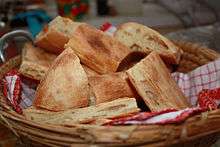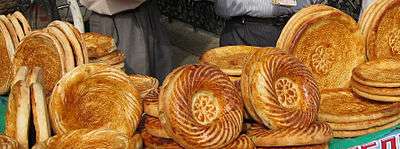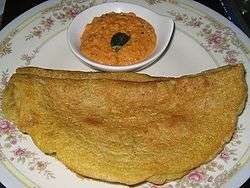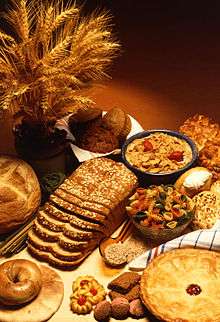Flatbread
|
Homemade flatbread | |
| Type | Bread |
|---|---|
| Main ingredients | Flour, water, salt |
|
| |
A flatbread is a bread made with flour, water and salt, and then thoroughly rolled into flattened dough. Many flatbreads are unleavened—made without yeast—although some are slightly leavened, such as pita bread.
There are many other optional ingredients that flatbreads may contain, such as curry powder, diced jalapeños, chili powder, or black pepper. Olive oil or sesame oil may be added as well. Flatbreads can range from one millimeter to a few centimeters thick.
List of flatbreads
Europe, Central and West Asia
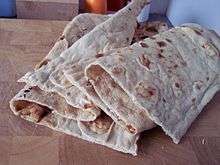
Afghan bread
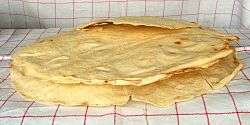
Pane carasau from Sardinia
- Afghan bread or "Nan" (Afghanistan)
- Bannock (Scotland)
- Barbari bread (Persia)
- Bazlama (Turkey): made from wheat flour, drinking water, and table salt
- Bolani (Afghanistan): a vegetarian flat-bread dish
- Farl (Ireland and Scotland)
- Flammkuchen/Tarte flambée (Alsace): thin bread dough rolled out in a circle or a rectangle and covered with onions and bacon
- Flatbrød (Norway): barley flour, salt and water
- Flatkaka (Iceland): rye flatbread
- Focaccia (Italy)
- Ftira (Malta)
- Gözleme (Turkey): folded over a savoury filling and fried on a griddle
- Hoggan (Cornwall): made from barley flour containing pieces of pork, and potato
- Lagana (Greece)
- Lángos (Hungary)
- Lavash (Armenia)
- Lefse (Norway)
- Matnakash (Armenia)
- Obi Non (Afghanistan and Uzbekistan)
- Opłatek (Poland)
- Pane carasau (Sardinia)
- Piadina (Italy): white flour, lard (or olive oil), salt and water
- Pide (Turkey)
- Pita (Greece)
- Pită/Lipie (Romania)
- Pizza (Italy)
- Podpłomyk (Poland)
- Rieska (Finland)
- Sacramental bread (Europe)
- Sangak (Persia)
- Sheermal (Persia and Indian subcontinent)
- Shelpek (Central Asia)
- Shotis Puri (Georgia)
- Somun and Lepina (Bosnia and Herzegovina)
- Spianata sarda (Sardinia)
- Taftoon Bread (Persia)
- Tandoor-nan (Central Asia)
- Tigella (Italy)
- Tonis Puri (Georgia)
- Torta (Spain)
- Torta al testo (Umbria, Italy)
- Torta de Gazpacho (Spain)
- Tunnbröd (Sweden): any combination of wheat, barley and rye
- Yufka (Turkey): wheat flour, water and table salt
Middle East and Africa

- Aish Merahrah (Egypt): made with 5 -10% ground fenugreek seeds and maize
- Barbari (Iran)
- Gurassa (Sudan)
- Harsha (Morocco): fried buttery bread made of semolina
- Injera (Horn of Africa): teff flour and water
- Khebz (Levant)
- Khobz rmal (Maghreb)
- Khubz (Arabian Peninsula)
- Lahoh (Somalia, Djibouti, Yemen)
- Malooga (Yemen): water, yeast, salt and flour
- Mlawi (Tunisia): water, olive oil, semolina and flour
- Chapati (Swahili coast, Uganda)
- Markook (Levant)
- Matzo (Israel): white plain flour and water
- Ngome (Mali): millet, water and vegetable oil
- Pita (Eastern Mediterranean and Middle East)
- Sangak (Iran)
- Taftan (Iran)
South and East Asia
- Bhakri (India): made with water and millet flour
- Bhatura (India): made with white flour, yogurt, ghee (or oil), and yeast
- Bindaeddeok (Korea): made from mung bean flour {this is a pancake, not a flatbread}
- Bing (China)
- Piaya (Philippines)
- Bánh (Vietnam)
- Chapati (India, Pakistan): made from atta flour (whole grain durum wheat), water and salt
- Poli (India): made from whole wheat flour, water and salt. It is folded and layered round flat bread.
- Phulka (India, Pakistan): made from whole wheat flour, water and salt. It is like a baked variety of Puri.
- Green onion pancake (China): made with oil and minced scallions (green onions)
- Paratha (India, Pakistan, Sri Lanka, Nepal)
- Khanom buang (Thailand): rice flour
- Laobing (China)
- Pateeri (Pakistan)
- Cheese Naan (Pakistan) A Naan bread filled with Cheeses and local seasoning
- Nutella Naan/Paratha (Pakistan) A Naan bread filled with Nutella or a Paratha with similar spread
- Luchi (East India and Bangladesh): fine maida flour with water and a spoonful of ghee
- Naan (Pakistan, Central and South Asia): leavened with yeast, unlike Roti bread
- Pol roti (Sri Lanka): made from scraped coconut and wheat or kurakkan flour, with green chillis and onion
- Puri (India, Pakistan, Nepal): prepared from dough of atta and salt
- Roast paan (Sri Lanka): bread mixture baked in a flat mold, producing, literally, a 'flat' bread
- Roti (Pakistan, Central and South Asia)
- Roti prata (Singapore)
- Roti canai (Malaysia and Indonesia)
- Sanchuisanda (China): baked in ashes[1]
Americas
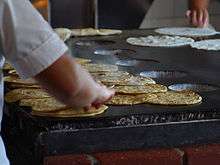
Preparing tortillas
- Arepa (Colombia, Venezuela): flat, unleavened patty made of cornmeal
- Bammy (Jamaica): made from grated cassava root or cassava flour and salt
- Beiju (Brazil): made from tapioca
- Casabe (South America, Caribbean): made from bitter cassava root
- Frybread (United States)
- Native American Flatbread (North America): made from maize flour in a traditional style of early Native Americans; now topped with ground beef, vegetables, beans and cheese
- Pan de Semita (Mexico)
- Johnnycake (Caribbean)
- Tortilla (Mexico, Central and South America)
- Tortilla de Rescoldo (Chile): wheat flour based bread, traditionally baked in the coals of a campfire
See also
References
- ↑ Sanchuisanda is described in "Peoples of China's Far Provinces", by Wong How-Man, National Geographic, March 1984.
Further reading
- 2005. "High-Profile Flatbreads - Say Goodbye to Insipid White Bread When Tortillas and Flatbreads Come to Town". FOOD PRODUCT DESIGN -NORTHBROOK-. 15, no. 1: 96-114. ISSN 1065-772X.
- 2008. "Flatbreads Old World: Meets New Flatbreads from All Over the World-Including Tortillas, Arepas and Naan-Are the Newest Hot Ticket in Both Retail and Foodservice Products". FOOD PRODUCT DESIGN -NORTHBROOK-. 18, no. 11: 38-43.
- 2008. "Storied Breads: With a Continuing Focus on Food Origin, Flatbreads Offer Manufacturers a Way to Tempt Consumers with Authentic Products Celebrating the Oldest-Known Bread Traditions". BAKING AND SNACK. 30, no. 7: 35-42. ISSN 1092-0447.
- 2010. "Glycaemic Index of Indian Flatbreads (Rotis) Prepared Using Whole Wheat Flour and Atta Mix-Added Whole Wheat Flour". British Journal of Nutrition. 103, no. 11: 1642-1647. ISSN 0007-1145.
- 2011. "Flat-Out in Love with Flatbread Here Are 5 Reasons Foodservice Is Smitten with Flatbreads". FOOD MANAGEMENT -NEW YORK THEN CLEVELAND OH-. 46, no. 11: 30-35. ISSN 0091-018X.
- Alford, Jeffrey, and Naomi Duguid. Flatbreads and Flavors: A Baker's Atlas. New York: W. Morrow, 1995. Summary: Recipes for more than sixty varieties of flatbreads along with 150 recipes for traditional accompaniments to the breads, including chutneys, curries, salsas, stews, mezze, smorgasbord, kebabs, etc.
- Craddock, Anne. Textural Characteristics of Bagels and Ethnic Flatbreads. 1998. Thesis. 124 leaves.
- German, Donna Rathmell. Flatbreads from Around the World. San Leandro, Calif: Bristol Pub, 1994.
- Hansen, Eric. 2015. "Fabled Flatbreads of Uzbekistan." Aramco World. July/August 2015. Pages 32–39.
- Helou, Anissa. Savory Baking from the Mediterranean: Focaccias, Flatbreads, Rusks, Tarts, and Other Breads. New York: William Morrow, 2007.
- Kahlon, Talwinder Singh, and Mei-Chen Maggie Chiu. 2014. "Ancient Whole Grain Gluten-Free Flatbreads". Food and Nutrition Sciences. 05, no. 17: 1717-1724.
- Khawaja K.I., et al. 2012. "Glycaemic, Insulin and Ghrelin Responses to Traditional South Asian Flatbreads in Diabetic and Healthy Subjects". British Journal of Nutrition. 108, no. 10: 1810-1817.
- Reinhold, John G., Bahram Faraji, Parichehr Abadi, and Faramarz Ismail‐Beigi. 1981. "An Extended Study of the Effect of Iranian Village and Urban Flatbreads on the Mineral Balances of Two Men Before and After Supplementation with Vitamin D†". Ecology of Food and Nutrition. 10, no. 3: 169-177.
This article is issued from Wikipedia - version of the 11/4/2016. The text is available under the Creative Commons Attribution/Share Alike but additional terms may apply for the media files.
